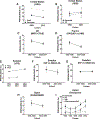Is Alzheimer's Disease Risk Modifiable?
- PMID: 30776012
- PMCID: PMC6708279
- DOI: 10.3233/JAD181028
Is Alzheimer's Disease Risk Modifiable?
Abstract
Population-based clinic-pathological studies have established that the most common pathological substrate of dementia in community-dwelling elderly people is mixed, especially Alzheimer's disease (AD) and cerebrovascular ischemic disease (CVID), rather than pure AD. While these could be just two frequent unrelated comorbidities in the elderly, epidemiological research has reinforced the idea that mid-life (age <65 years) vascular risk factors increase the risk of late-onset (age ≥ 65 years) dementia, and specifically AD. By contrast, healthy lifestyle choices such as leisure activities, physical exercise, and Mediterranean diet are considered protective against AD. Remarkably, several large population-based longitudinal epidemiological studies have recently indicated that the incidence and prevalence of dementia might be decreasing in Western countries. Although it remains unclear whether these positive trends are attributable to neuropathologically definite AD versus CVID, based on these epidemiological data it has been estimated that a sizable proportion of AD cases could be preventable. In this review, we discuss the current evidence about modifiable risk factors for AD derived from epidemiological, preclinical, and interventional studies, and analyze the opportunities for therapeutic and preventative interventions.
Keywords: Alcohol drinking; Alzheimer’s disease; dementia; diabetes mellitus; diet; education; exercise; hyperlipidemia; hypertension; smoking.
Figures



References
Publication types
MeSH terms
Grants and funding
LinkOut - more resources
Full Text Sources
Medical

